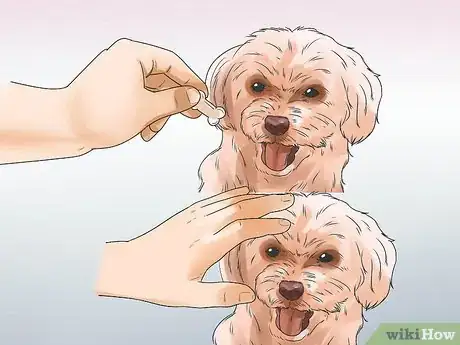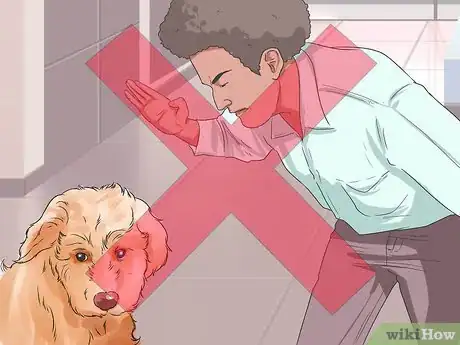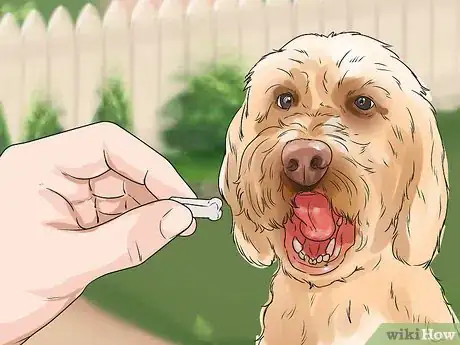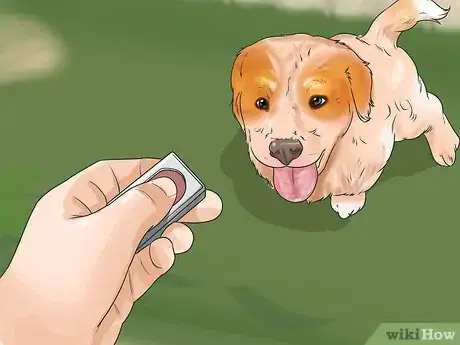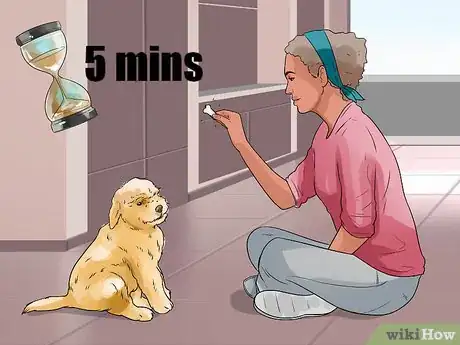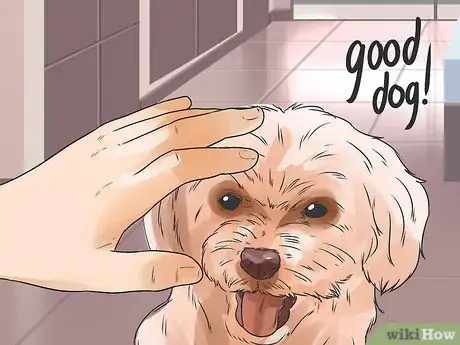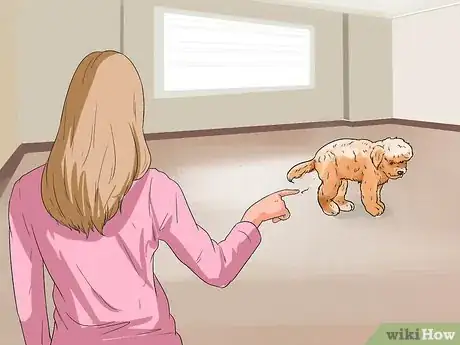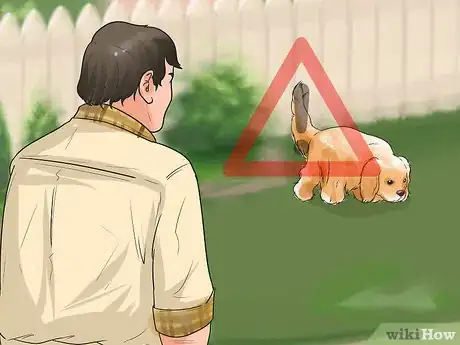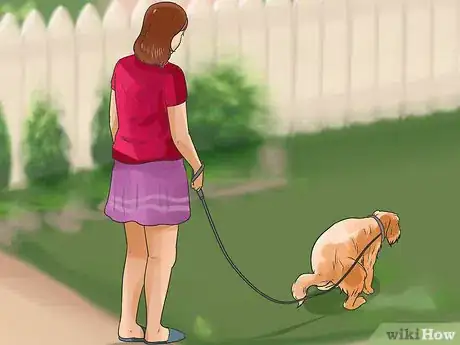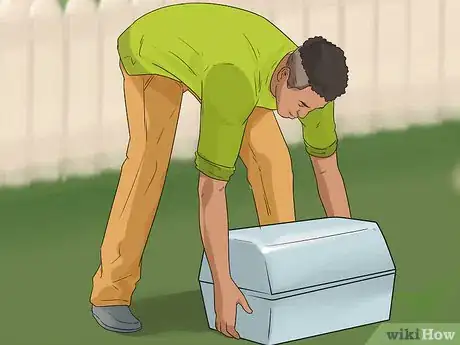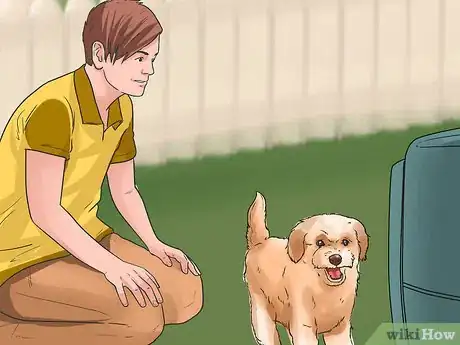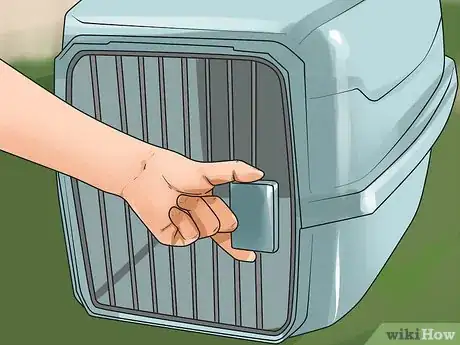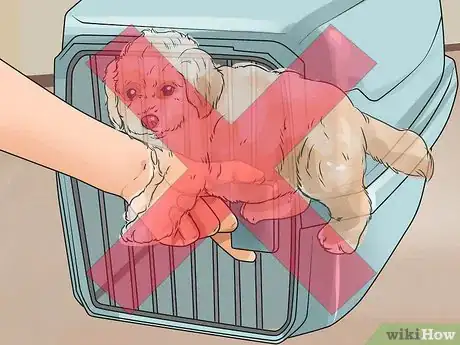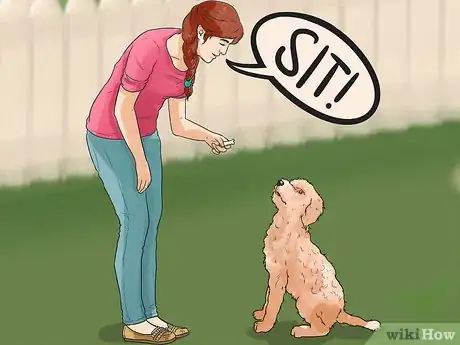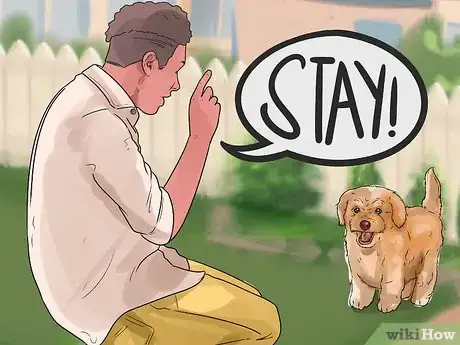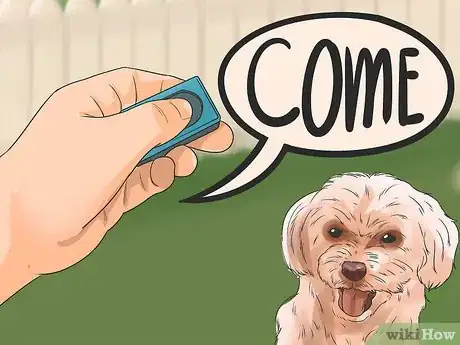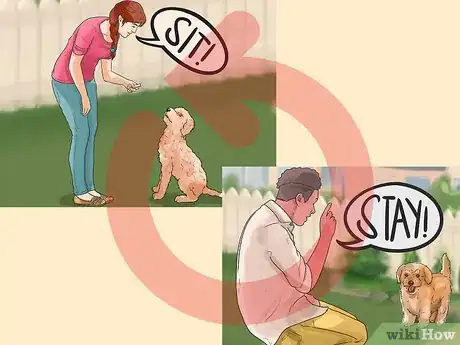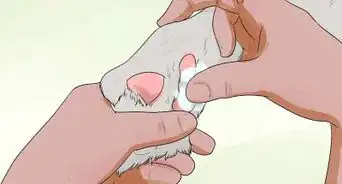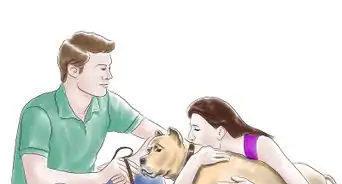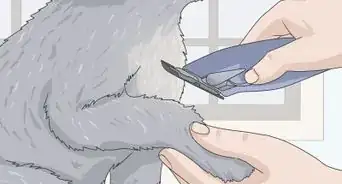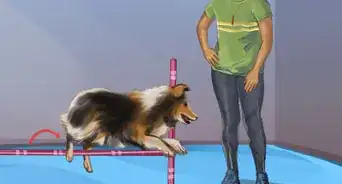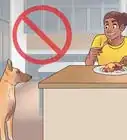This article was co-authored by Brian Bourquin, DVM. Brian Bourquin, better known as “Dr. B” to his clients, is a Veterinarian and the Owner of Boston Veterinary Clinic, a pet health care and veterinary clinic with three locations, South End/Bay Village, the Seaport, and Brookline, Massachusetts. Boston Veterinary Clinic specializes in primary veterinary care, including wellness and preventative care, sick and emergency care, soft-tissue surgery, dentistry. The clinic also provides specialty services in behavior, nutrition, and alternative pain management therapies using acupuncture, and therapeutic laser treatments. Boston Veterinary Clinic is an AAHA (American Animal Hospital Association) accredited hospital and Boston’s first Fear Free Certified Clinic. Brian has over 19 years of veterinary experience and earned his Doctor of Veterinary Medicine from Cornell University.
There are 8 references cited in this article, which can be found at the bottom of the page.
This article has been viewed 37,834 times.
Described by some as a "designer dog," the goldendoodle is a cross between a golden retriever and a poodle. This is a large dog, weighing around 50-90 lbs, that requires a lot of exercise, but has a wonderfully friendly and affectionate personality. The goldendoodle is also an intelligent creature, who takes instruction willingly but can get bored or obstinate if it doesn't receive an appropriate outlet for its energy. Thus, it is important to train your goldendoodle from an early age, and teach commands, such as a good recall, so that it can burn of energy running off leash but return to you on command.
Steps
Using Basic Principles of Training
-
1Use rewards-based training.[1] Modern dog training methods are based on rewards and encouragement, rather than punishment. This teaches the dog that when they perform a desired action, such as "Sit" or "Stay", they get a reward. [2]
- Rewards make your dog keen to do as you ask, so training is centered on communicating to your dog that if they do a certain action, they will get a treat.
-
2Avoid using punishment for training. Harsh methods that involve dominating the dog are out-dated. While these methods might appear to work, the dog is behaving out of fear of punishment from the owner, rather than thinking for itself and making decisions about what it appropriate behavior and what is not. [3]
- In addition, physical punishment can lead the dog to become frustrated or anxious. This can then lead to pent up anger, which can then spill over as aggression.
Advertisement -
3Use rewards that your dog will respond to. The goldendoodle is a food-motivated dog, which makes giving small food rewards an ideal way of motivating your dog and rewarding those behaviors you wish to teach. However, rewards come in all shapes and sizes, and range from food tidbits to praise or play with a toy. Key to successful training is to work out what your dog will work for. If it likes playing with a tug toy, then a brief game of tug could be your way of motivating him. [4]
-
4Consider using clicker training. Many people who choose to reward their dog with small treats can pair this with clicker training. Clicker training is a neat way of marking a desired behavior, to let the dog know what they are being rewarded for. The principal behind clicker training is to first teach the dog to link the click-clack of the clicker to getting a reward. Then you make the desired action with the click-clack.[5] [6]
- For example, when teaching "Sit," you lure the dog into a sitting position and press the clicker as soon as the dog's bottom hits the ground.
-
5Do frequent but brief training sessions with puppies. Remember your puppy has a short attention span, so several 5 minute sessions spaced over the day are better for an 8 - 10 week old puppy than one long session. Gradually increase the length of the training session as its concentration and stamina improves.
-
6Always end your session on a positive note. If the dog or puppy is getting distracted, bring the training session to a close with a simple command you know it can do. This will allow you to praise it and leave it feeling happy with itself.[7]
Toilet Training Your Goldendoodle
-
1Start toilet training your goldendoodle as soon as you bring it home. Set up a puppy room in which the dog will sleep and eat, rather than letting it roam all over the house. Letting it roam your whole home will make potty training more difficult, as you will have a harder time keeping track of what it is doing. Take the puppy straight out to the spot that you intend it to use as a toilet. Pop it down on the spot and if the dog happens to 'go,' give it heaps of praise.[8]
- The idea is for the dog to associate going to the bathroom in that spot with getting heaps of praise. This makes it worthwhile for the dog to save up its bodily functions in return for adoration.
-
2Don't get discouraged and be vigilant. Of course potty training doesn't happen instantaneously and you need to stick at it. Training requires the puppy to learn where it is meant to go, and where it shouldn't go. To teach the later means constant vigilance. Watch it indoors like a hawk and when the dog shows the earliest signs of wanting to toilet, such as sniffing with great concentration or sidling up to objects, then pick it up and take it outside to the toilet spot. Then when the dog goes in the right place, lavish it with praise.
-
3Take the dog out frequently. An adult dog that has never been potty trained should be able to hold it for several hours once trained. However, to increase your success rate, take an 8 week old puppy outside every 20-30 minutes. If you can't be with the puppy in between toilet stops, then pop it in its crate rather than letting it go to the bathroom in the house. Also, puppies tend to toilet about 20 minutes after eating, so put him outside after each meal, and likewise immediately after eating.[9]
-
4Clean up accidents thoroughly. If the dog or puppy does have an accident indoors, be sure to thoroughly clean it up. There should be no lingering odor left behind once you have cleaned it.
- A lingering odor could draw it back to use the same spot once again.
Crate Training Your Goldendoodle
-
1Set up the crate. The idea behind crate training is to create a space that belongs to the puppy which is their den.[10] Choose a crate that is big enough for the puppy to stand up in without banging its head, and can lie down with its legs stretched out. An average male Goldendoodle can stand 2 feet (0.61 m) tall to the shoulder, so take this into account when choosing a crate.[11]
- Pop a comfortable bed in the crate, a water bowl in one corner and some toys. At times when you can't be there to supervise the puppy, this is a safe place to confine it so that it can't chew household items. [12]
- Putting a dog in a crate can also aid in house training. Natural instinct dictates that a puppy is less likely to soil its den, so staying in a crate teaches it some bladder control. However, you should never leave a dog in a crate for too long.
-
2Encourage the dog to explore the crate on its own. Puppies readily learn to like the crate if you help them to discover that it is a place where good things happen. Seed it with treats for the puppy to pop in and discover. Feed the dog in the crate so that it associates the crate with meal times. [13]
- Give it a chew toy while it is in the bed, but leave the door open. Early crate training is all about the dog getting comfortable and happy in the crate.
-
3Gradually begin shutting the door. Once the dog is popping in regularly to investigate if any treats have appeared, you can start to shut the door. At first this is just for a few seconds, perhaps while the dog is eating. When it is calm and quiet with the door closed, give it lots of praise.[14]
- Gradually extend the amount of time the door is closed, until it is equally happy with the door open or closed.
-
4Don't reward discontent. If the puppy cries while in the crate, don't release him while it is crying. If you respond to its cries then it will have trained you to let it out, and it may become ever more vocal if you don't do so. Instead, wait until the dog is quiet and then set it free, so that the good behavior is rewarded.
Teaching Basic Commands
-
1Teach your dog to sit. It is essential for your goldendoodle to obey basic commands, such as "sit", "stay", and "come." If your dog obeys these instantaneously, you can control it in pretty much any situation.[15] Begin this training with the "sit" command, and then follow with other commands once your dog has mastered "sit."[16]
- To teach "sit", use a food lure. Hold a small treat between your finger and thumb. Hold it just in front of the dog's nose, and when you have its attention, raise the treat in an arc going back over its head.
- As its nose follows the treat, its bottom naturally sinks to the ground. As soon as its butt contacts the floor, press the clicker. Then reward the dog with a treat.
- Start adding in the vocal command "sit" as you show the dog the treat. This tells it what action it is you require.
- If using a clicker, as it sits, then click.
-
2Teach "Stay" once he has mastered "Sit". Put the puppy into a sit and then hold your hand up, palm towards the puppy in a "Stop" signal. Say "Stay" and take a small step back. Wait for a few seconds to ensure the pup doesn't move, then pat your thighs and call the puppy's name and say "Come" a bright voice. Reward him when he runs to you.
-
3Teach the dog to "come." To teach come, play with the puppy and take a couple of steps away from it. A puppy's natural instinct is to stay close to their mother, or minder, and so it will run to rejoin you. As soon as it moves toward you click your clicker or say "come," and then give it a treat when it arrives.[17]
- This is a very important skill for your dog to have, for both good interaction and for its safety.
-
4Use repetition and don't get discouraged. Keep repeating this desired action until the dog gets the hang of things, which may take quite awhile. Using these basic principles, you can train a dog to do more complex commands or tricks.
- However, don't overwhelm your goldendoodle. Break complex tricks down into their individual components and teach one element at a time, then add them together for a more complex trick.
- You can make training into a fun game with your dog. For example, throw a toy in the yard for your dog and train the dog it to bring it to you when you say a specific command, make it wait when you say "stay," and come back to your without it if you say "come." A goldendoodle, with its great intelligence should be up to this task with enough training.
Expert Q&A
-
QuestionWhat's the best way to train a Goldendoodle?
 Brian Bourquin, DVMBrian Bourquin, better known as “Dr. B” to his clients, is a Veterinarian and the Owner of Boston Veterinary Clinic, a pet health care and veterinary clinic with three locations, South End/Bay Village, the Seaport, and Brookline, Massachusetts. Boston Veterinary Clinic specializes in primary veterinary care, including wellness and preventative care, sick and emergency care, soft-tissue surgery, dentistry. The clinic also provides specialty services in behavior, nutrition, and alternative pain management therapies using acupuncture, and therapeutic laser treatments. Boston Veterinary Clinic is an AAHA (American Animal Hospital Association) accredited hospital and Boston’s first Fear Free Certified Clinic. Brian has over 19 years of veterinary experience and earned his Doctor of Veterinary Medicine from Cornell University.
Brian Bourquin, DVMBrian Bourquin, better known as “Dr. B” to his clients, is a Veterinarian and the Owner of Boston Veterinary Clinic, a pet health care and veterinary clinic with three locations, South End/Bay Village, the Seaport, and Brookline, Massachusetts. Boston Veterinary Clinic specializes in primary veterinary care, including wellness and preventative care, sick and emergency care, soft-tissue surgery, dentistry. The clinic also provides specialty services in behavior, nutrition, and alternative pain management therapies using acupuncture, and therapeutic laser treatments. Boston Veterinary Clinic is an AAHA (American Animal Hospital Association) accredited hospital and Boston’s first Fear Free Certified Clinic. Brian has over 19 years of veterinary experience and earned his Doctor of Veterinary Medicine from Cornell University.
Veterinarian Goldendoodles respond well to rewards-based training so give them their favorite treats when they behave.
Goldendoodles respond well to rewards-based training so give them their favorite treats when they behave.
Warnings
- Goldendoodles are not well adapted to living in a confined space, such as an apartment, and do best in a larger dwelling with ready access to an outside yard.⧼thumbs_response⧽
References
- ↑ Brian Bourquin, DVM. Veterinarian. Expert Interview. 20 December 2019.
- ↑ https://www.dogstrust.org.uk/help-advice/factsheets-downloads/basicdogtrainingfactsheetnov13.pdf
- ↑ http://www.humanesociety.org/animals/dogs/tips/teaching_basic_commands.html
- ↑ https://www.dogstrust.org.uk/help-advice/factsheets-downloads/basicdogtrainingfactsheetnov13.pdf
- ↑ http://www.akc.org/learn/akc-training/what-is-clicker-training-a-great-way-to-shape-your-dogs-behavior/
- ↑ http://www.humanesociety.org/animals/dogs/tips/teaching_basic_commands.html
- ↑ https://www.dogstrust.org.uk/help-advice/factsheets-downloads/basicdogtrainingfactsheetnov13.pdf
- ↑ http://www.thekennelclub.org.uk/getting-a-dog-or-puppy/general-advice-about-caring-for-your-new-puppy-or-dog/toilet-training-for-puppies/
- ↑ http://www.thekennelclub.org.uk/getting-a-dog-or-puppy/general-advice-about-caring-for-your-new-puppy-or-dog/toilet-training-for-puppies/
- ↑ Brian Bourquin, DVM. Veterinarian. Expert Interview. 20 December 2019.
- ↑ http://dogtime.com/dog-breeds/goldendoodle#/slide/1
- ↑ http://dogtime.com/dog-breeds/goldendoodle#/slide/1
- ↑ http://www.humanesociety.org/animals/dogs/tips/crate_training.html?credit=web_id101199907
- ↑ http://www.humanesociety.org/animals/dogs/tips/crate_training.html?credit=web_id101199907
- ↑ http://dogtime.com/dog-breeds/goldendoodle#/slide/1
- ↑ http://www.akc.org/learn/akc-training/what-is-clicker-training-a-great-way-to-shape-your-dogs-behavior/
- ↑ http://www.humanesociety.org/animals/dogs/tips/teaching_come_command.html
About This Article
To train goldendoodles, use reward-based training to teach the dog that it will get a reward when it performs a desired action. You can also pair reward-based training with clicker training, which is another way to mark a dog’s good behavior. When working with your dog, do several 5 minute training sessions a day since dogs have short attention spans. After each session, praise your dog's hard work to leave it feeling happy and ready to train again later. For more tips from our Veterinary co-author, including how to toilet train your goldendoodle, keep reading!
